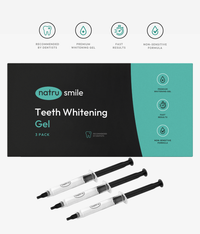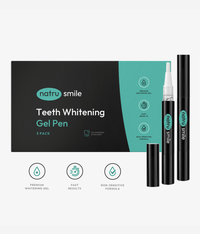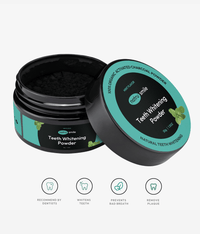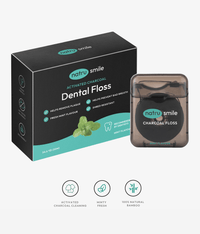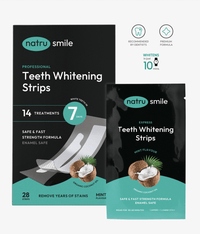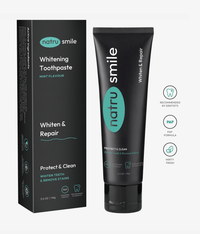
All products are certified by dental expert Dr. Greg Grillo
Angular cheilitis, also known as angular stomatitis, is a common and often uncomfortable skin condition. A painful patch on the corner of your lips may seem like a simple mouth sore, and while most often easily treatable, it can also be an indication of an underlying health condition.
In this article, we will explore everything there is to know about this skin condition and what the best angular cheilitis treatment options are.
What Is Angular Cheilitis? A Quick Look
Angular cheilitis is an infection of the corners of the mouth caused by a fungal or bacterial infection. It usually presents itself as red, tender, and swollen lesions that often crack open and ooze pus. This condition can be quite painful for those affected and can lead to difficulty eating or speaking.
In some cases, it may also be an indicator of nutritional deficiencies, such as vitamin B deficiency. An angular cheilitis treatment can range from topical creams to antibiotics depending on the severity and underlying cause.
In more severe cases of angular cheilitis, surgery may be recommended to remove excess tissue that has built up in the corner of the mouth due to inflammation. This can help reduce the severity of symptoms and improve the overall appearance.
Lifestyle modifications such as increasing hydration, avoiding irritants, and ensuring adequate nutrition may be beneficial in preventing the recurrence of the condition.
Stages Of Angular Cheilitis
To understand how to treat angular cheilitis, one must first understand its stages of development. Here are the four stages of angular cheilitis so that you have a better understanding of how you should handle it in the event that it occurs.
Minor Angular Cheilitis
In its early stages, this condition is known as minor angular cheilitis. Inflammation usually occurs only in one or both corners of the mouth. The area may appear red and swollen with cracks at the edges.
Minor angular cheilitis is marked by dry, flaky skin and may also cause tightness and slight pain when opening the mouth wide. This irritation can cause discomfort when talking or eating due to cracking or dryness of lips when trying to open your mouth wider than usual for chewing food. The affected area can also become tender and itchy.
Mild Angular Cheilitis
At this stage, mild angular cheilitis may present as redness and swelling around both sides of the mouth that are greater in length and depth than at the first stage. There may also be cracking at these sites, which can lead to fissures that are painful when stretched or exposed to saliva or food particles.
In some cases, there may also be small bumps filled with pus accompanied by a burning sensation. While not usually a harmful condition, it can be uncomfortable and cause an individual to experience decreased appetite, difficulty eating or speaking, and social embarrassment due to its visible appearance.
Severe Angular Cheilitis
At this stage, multiple sores appear on both corners of the mouth and can spread down to the chin area. A significant number of cracks and fissures are now extending from the angles of the mouth into the skin.
The affected area may be red, swollen, itchy, and filled with pus-filled blisters that ooze fluid when scratched. Left untreated, severe angular cheilitis can lead to permanent scarring on the lips and even disfigurement of the face.
Chronic Angular Cheilitis
Chronic angular cheilitis is the fourth and final stage of this skin condition which can last for years if left untreated. Symptoms may include redness and swelling, dryness and cracking, soreness or burning sensations at the corners of the mouth, as well as an unpleasant smell emanating from the affected area.
As the condition advances, the skin does not display cracks or fissures, but erythematous skin becomes contagious to the lip margin.
Who Gets Angular Cheilitis?
Angular cheilitis can affect anyone, including the very young and the very old, and several factors increase its risk.
Angular cheilitis most commonly affects individuals with the following:
- Asthma - Inhaled corticosteroids are taken to lessen the immune system's reaction in your airways, leading to decreased inflammation. However, this could also lead to a decrease in the inflammatory response in your mouth and cause the elimination of normal bacteria, resulting in angular cheilitis.
- Elderly - As we age, our skin loses some of its elasticity which can cause cracks in the corners of the mouth that make it easier for bacteria and fungi to enter and cause an infection.
- Children - Kids who drool a lot and have too much saliva in their mouths tend to be more likely to get angular cheilitis, particularly those who breathe through their mouths while asleep.
- Malnutrition - Nutritional deficiencies such as iron, B vitamins, zinc, or other essential minerals can leave individuals vulnerable to bacterial infections that may lead to angular cheilitis.
- Dentures - Poorly fitted dentures can cause the corners of the mouth to rub, which creates cracks and fissures in the skin that may lead to an infection.
- Dry mouth or dehydration - Saliva helps protect against infections, so when individuals have a dry mouth due to dehydration or certain medications, they are more prone to developing angular cheilitis.
- Diabetes - Angular cheilitis is characterized by a red, crusty lesion at the corners of the lips, often occurring in diabetics with poor sugar levels. Median rhomboid glossitis presents as an empty, reddened diamond-shaped patch on the back of the tongue and resides in the midline.
- Acid reflux - Acid reflux can cause stomach acid to enter the mouth and irritate the corners of the lips, which may result in angular cheilitis.
While this may occur, angular cheilitis typically isn't a severe condition and can often be resolved in a few weeks with treatment. Be aware, however, that even after being treated, angular cheilitis has a tendency to recur.
Symptoms Of Angular Cheilitis
There are several symptoms associated with angular cheilitis, including:
- Redness and inflammation around the corners of the mouth
- Cracks at either corner of the mouth
- Pain when speaking or eating
- Dry lips
- Bad breath
- Swelling in the skin folds near the mouth
- Difficulty smiling or speaking normally due to discomfort
- White patches on lips due to the build-up of dead skin cells (known as fissures)
You can feel your lips and mouth burning from angular cheilitis, which can cause them to feel dry and uncomfortable. Strong irritation can make eating difficult, resulting in weight loss.
Pictures Of Angular Cheilitis
Here are images of angular cheilitis to provide insight into what this condition looks like and how severe it may be in certain cases.
By understanding the physical characteristics associated with angular cheilitis, you can better understand how to manage it effectively.
Patches of cracked and dry skin around the mouth corners are signs of mild angular cheilitis.
Angular cheilitis is commonly seen in children. A healthy diet and proper dental hygiene are a must from an early age.
Angular cheilitis may be the result of iron deficiency anemia, accompanied by redness and inflammation. The condition can, however, have many other causes.
The spread of angular cheilitis across the chin area is possible in severe cases.
Causes Of Angular Cheilitis
Fungal infection from a type of yeast called candida may be one of the most common causes of angular cheilitis. This type of yeast is usually found on the skin and inside the body without causing any issues.
If this spreads to areas like the corners of the mouth and an environment conducive to its growth is created, an infection can occur.
Another major factor is poor oral hygiene, which can lead to bacteria and other microorganisms thriving in the mouth and on the skin around it. This could cause irritation or inflammation of the area, leading to angular cheilitis if left untreated.
Saliva accumulation at night due to open-mouth sleeping can also cause angular cheilitis. Saliva can accumulate on the sides of the mouth, leading to dryness and cracking. Bacteria and fungi can infect the mouth, causing inflammation and infection.
Finally, environmental factors like cold weather or sun exposure can also contribute to this condition by drying out the lips and making them more susceptible to injury from bacteria and fungi.
Risks Of Angular Cheilitis
The risk of angular cheilitis can be increased by certain medical conditions, including:
Diabetes
People with diabetes are particularly prone to fungal infections such as angular cheilitis because of their increased levels of glucose in the blood.
This excess glucose can create an ideal environment for fungi like candida to thrive, and weakened immune systems due to diabetes may make it more difficult for individuals to defend against infection.
Inflammatory Bowel Disease
Inflammatory bowel diseases (IBD) are marked by ongoing inflammation of the digestive tract walls, which arises as a result of interactions between microorganisms and people who have a genetic predisposition.
Angular cheilitis, cobblestoning of mucous membranes in the mouth, swellings on the lips with vertical cracks, and redness around the mouth area, among others, are all oral indicators of IBD.
Anemia
Iron-deficiency anemia is often overlooked as a contributing factor to angular cheilitis, which is characterized by painful cracking and fissuring of the mucosa and skin at the corners of the mouth. It has been observed that 14% of cases of iron-deficiency anemia are associated with angular cheilitis.
Down Syndrome
It appears that people with Down syndrome are more likely to develop angular cheilitis due to structural changes in their jaws and teeth.
The small size of their upper jaw can lead to overcrowding of the teeth, which in turn can cause permanent teeth not to have enough space or room to come in properly. This may create a gap between the lips, making it easier for bacteria or fungi to enter and cause an infection like angular cheilitis.
Immune System Illnesses
Angular cheilitis is not always caused by a particular microorganism, like cold sores. This means that it is unlikely to be transmitted through contact with another individual, such as kissing or sharing drinks. Individuals living with HIV and who are immunocompromised, however, can be affected by angular cheilitis due to candida.
Cancer
Angular cheilitis is not necessarily indicative of any sort of cancer or internal medical issue, but it's important to be aware that certain types of cancer, such as blood, kidney, liver, lung, and pancreatic cancers, are also capable of manifesting this condition.
How Is Angular Cheilitis diagnosed?
Diagnosis of angular cheilitis typically involves an examination of symptoms by a doctor or dentist. The doctor will look for early signs such as redness, swelling, cracking, or peeling skin around the mouth. They may also take swabs from inside your mouth to check if any underlying infections are present.
Moreover, a specialist may ask questions about lifestyle habits, such as eating habits or dental hygiene, since these factors can play a role in the development of angular cheilitis.
How To Heal Angular Cheilitis
Angular cheilitis is treated according to the underlying cause. Among the treatments available are:
- Antiseptic Creams or Ointments - These can be applied to the affected areas to reduce inflammation and promote healing. Topical Corticosteroids - These may be prescribed by a doctor in cases of severe angular cheilitis, as they are more effective at reducing inflammation than antiseptics alone.
- Oral Antibiotics - In cases where the infection is present, an oral antibiotic may be prescribed by a doctor to help fight off the bacteria causing the infection and reduce symptoms of angular cheilitis.
- Vitamin B Complex - Taking vitamin B supplements can effectively reduce the symptoms of angular cheilitis by boosting immune system function and speeding up healing.
- Hydrating Lip Balm - Applying a lip moisturizer regularly to the affected areas prevents further cracking and irritation from occurring.
- Antifungal Treatment - Antifungal medications may be prescribed if angular cheilitis is caused by a fungal infection.
Home Remedies To Cure Angular Cheilitis Overnight
While it may not always be possible to cure angular cheilitis overnight, there are certain natural treatments and home remedies that you can try at home to help relieve your symptoms and get rid of this uncomfortable condition quickly.
Here are some ways to reduce the discomfort associated with angular cheilitis and help promote the healing of the skin:
Essential Oils
Natural compounds found in plants and infused into essential oils can be used to relieve and treat a wide range of ailments, including angular cheilitis. In spite of limited research, it has been found that essential oils, such as those from thyme, clove, rose, eucalyptus, fennel, and bergamot, can help reduce inflammation when used as antioxidants.
Baking Soda
The natural antiseptic properties of baking soda make it effective for treating fungal and bacterial infections, such as angular cheilitis. Make a paste by mixing a tablespoon of baking soda with water and applying it to the affected areas for a few minutes before rinsing it off.
Honey
Honey has been used for centuries to treat angular cheilitis due to its antifungal and antimicrobial properties. This is widely accepted by many cultures as food and medicine, with records of its use going back thousands of years. Recently, honey has been discovered to be effective in treating infections such as angular cheilitis topically.
Salt Water
Although the initial application of salt may cause a burning sensation, it is worth attempting as its natural antiseptic properties can help reduce the infection and stop it from worsening.
To alleviate the itching due to a fungal infection, consider taking a warm salt water bath or applying a washcloth or cotton ball to the affected areas.
Apple Cider Vinegar
The antibacterial and antifungal properties of apple cider vinegar (ACV) make it effective against the germs that cause angular cheilitis. Its anti-inflammatory qualities can help soothe sore skin, while undiluted or lightly diluted ACV may also stop the growth of candida.
Garlic
Garlic has a compound called Allicin that fights off fungus. Even certain cancers may be prevented, and blood glucose, cholesterol, and blood pressure may be lowered with this compound. Applying garlic topically, in the form of a paste, is beneficial for treating angular cheilitis and its symptoms, including itching and swelling.
Jojoba Oil
Jojoba oil is a highly hydrating ingredient that helps draw water to the top layer of skin and keep it moisturized. This can help reduce the risk of bacterial infections, acne, and dandruff occurring.
Additionally, this oil has several healing properties that may be beneficial for angular cheilitis treatment, as well as for various skin issues like eczema, psoriasis, and acne. You can use it directly on your body as a cleanser, moisturizer, or spot treatment without diluting it.
Petroleum Jelly
Petroleum jelly can be used to keep the affected area of angular cheilitis soft and hydrated, which helps promote healing. Petroleum jelly is an emollient which works by forming an oily layer on the skin's surface that helps to lock in moisture, reduce itching and flaking, and soothe irritation.
Lemon
Lemon juice is a great source of vitamin C, which gives it natural immunity-boosting properties that can help to heal certain conditions. Applying products containing lemon extract can also benefit from this drying effect and antiseptic action to eliminate bacteria.
Yogurt
Using yogurt to treat angular cheilitis is a smart idea because it contains live cultures that can reduce inflammation and keep the skin moisturized. The probiotic strain lactobacillus acidophilus is especially effective at killing candida.
Applying natural yogurt with a q-tip directly onto affected areas will help to relieve symptoms.
Coconut Oil
Studies suggest that the application of melted coconut oil can help fight off fungal growth in the mouth while also providing moisture to prevent further damage to the lips. To apply, simply heat up the oil in a microwave for a few seconds until it is cool enough not to burn the skin, then spread it onto affected areas for at least thirty minutes.
Olive Oil
Using olive oil can hydrate the affected area, combat fungal infections, and reduce inflammation. Fluconazole-resistant and dose-dependent sensitive fungal strains may be controlled with ozonated olive oil.
Aloe Vera
Aloe vera is widely known for its healing powers and is often used to soothe irritated skin and ward off infection. The gel of this plant contains plenty of water that cools and relieves dryness. Aloe vera's anti-inflammatory properties reduce any pain, itching, or dryness associated with angular cheilitis.
Neem Oil
Derived from the seed kernels of a Neem tree, neem oil helps soothe inflammation and pain associated with fungal infections.
For optimal results when treating acne, warts, moles, or angular cheilitis, use undiluted neem oil on the affected areas. Apply it using a cotton swab or cotton ball, then let it sit for up to 20 minutes before rinsing it off with warm water.
How To Prevent Angular Cheilitis
You can reduce your risk of getting angular cheilitis. Here are some reliable ways:
- Avoid licking your lips - Saliva can cause the corners of your mouth to become dry and cracked, so try not to lick them.
- Keep your face clean - Wash your face twice a day with a gentle cleanser and lukewarm water, then apply a layer of moisturizer to keep the skin hydrated.
- Stay hydrated - Drink plenty of water throughout the day to keep your body hydrated and help prevent mouth dryness.
- Use an emollient ointment or cream - Apply it around the corners of your mouth several times daily to help keep your skin hydrated and soft.
- Avoid allergens - If you are allergic to certain foods, try to avoid them as much as possible since they can exacerbate the condition.
- Protect against chapping - If you’re exposed to extreme temperatures or windy conditions, cover your face with a scarf or hat to protect it from further damage.
- Use antifungal or antibiotic medications - If the condition is caused by a fungal or bacterial infection, ask your doctor to prescribe appropriate medication.
- Avoid smoking - Smoking can make angular cheilitis worse, so if you’re a smoker, it's advisable to refrain from smoking as much as possible.
- See your dentist - Check with your dentist to rule out any dental problems.
By understanding what causes it and how it can be prevented, you can better protect yourself from this unpleasant condition.
Cold Sore Vs Angular Cheilitis
Cold sores and angular cheilitis are both painful conditions that can appear on the lips and mouth. They present with similar symptoms, but the underlying cause of each is different.
Knowing the differences between cold sores and angular cheilitis can help you determine which one you may have and how to treat it properly.
Cold sores, also known as fever blisters, are caused by a virus called herpes simplex 1 (HSV-1). Most cases of HSV-1 are transmitted from person to person via oral contact.
Angular cheilitis, on the other hand, is an infection caused by bacteria or fungus that affects the corners of your mouth. In contrast to cold sores, angular cheilitis isn't contagious.
Treatment for cold sores usually involves over-the-counter medications such as Abreva and Zovirax, while angular cheilitis needs to be treated with topical antifungal creams or antibiotics prescribed by a doctor.
If you’re uncertain about which one you may have, it’s best to consult a doctor for a diagnosis before trying any home remedies or over-the-counter medications.
Remedies For Angular Cheilitis
In spite of the ease and accessibility of angular cheilitis treatment, it can still be extremely uncomfortable and embarrassing.
Here are some common remedies for angular cheilitis that may help provide relief:
- Antifungal Creams - If the cause of your angular cheilitis is a fungal infection, applying an antifungal cream such as clotrimazole or miconazole can help reduce symptoms and promote healing. These creams are available over the counter at most pharmacies.
- Hydrocortisone Cream - This cream may reduce inflammation and irritation associated with angular cheilitis. Hydrocortisone is a corticosteroid (steroid). To reduce pain, itching, and swelling, it calms the immune system. The use of this should not be prolonged without consulting your doctor, as prolonged use may cause the skin to thin and become fragile.
Your doctor may also suggest applying petroleum jelly to the areas that are inflamed and taking a vitamin B complex supplement.
These will help keep your mouth from becoming too dry, allowing the sores to heal more quickly, as well as providing your body with the essential nutrients needed for faster recovery.
Angular cheilitis is frequently asked about, so here are some key points of information.
Are Mouth Sores Always The Result Of Angular Cheilitis?
The corners of the lips can become cracked and sore for reasons other than angular cheilitis.
According to the Cleveland Clinic, these issues might include actinic keratosis, a precancerous skin condition; HSV-1 or fever blisters; leukoplakia, which is white patches in the mouth that could be precancerous; oral cancer; oral lichen planus, a disorder of the lining of the mouth; and syphilis, an STI resulting in red sores on either the genitals or around the mouth.
What Can I Do To Make Living With Angular Cheilitis Easier?
When it comes to alleviating the symptoms of angular cheilitis, simple measures such as ensuring that your lips remain moisturized, practicing proper oral hygiene, and following a healthy diet can work wonders. You should also avoid irritants, such as strong toothpaste and mouthwash.
What Antifungal Cream Is Best For Angular Cheilitis?
You may consult your pharmacist for an appropriate antifungal cream, such as Nystatin, Clotrimazole, or Miconazole. Often referred to as a "triple antibiotic," Neosporin is a combination antibiotic over-the-counter ointment that can be used to treat minor injuries such as cuts, scrapes, and burns.
Make sure to clean and dry the affected areas before applying. Use a cotton applicator to apply the cream four to five times per day around the mouth.
Can Oral Herpes Cause Angular Cheilitis?
Cold sores, also called oral herpes or HSV-1, can cause symptoms similar to angular cheilitis. Although they both may present as inflammation around the mouth area, they are not the same condition and have different causes.
Angular cheilitis is typically caused by a fungal infection, while oral herpes is usually spread through physical contact, such as kissing or engaging in sexual activity with someone who has an active sore.
How Do You Treat Mild Angular Cheilitis?
Mild angular cheilitis can be treated with simple home remedies. Start by gently cleaning the corners of your mouth with a soft, damp cloth, and avoid any harsh soaps or chemicals that may further irritate the area.
Additionally, applying an over-the-counter antifungal cream to the affected area twice a day can help reduce inflammation and promote healing. If these treatments fail to work after several days, it's best to see a doctor for more specialized care.
Why Won't My Angular Cheilitis Go Away?
For some individuals, angular cheilitis is chronic and will have to be dealt with for their lifetime. To determine what type of treatment is best, it's advisable to speak with a doctor who can take swabs and suggest an appropriate solution and medication.
Why Do I suddenly Have Angular Cheilitis?
Angular cheilitis can be triggered by a number of factors, including improper nutrition, stress, aging, dehydration, and poor oral hygiene. Additionally, some medical conditions, such as diabetes and autoimmune disorders, may also increase one's risk of developing angular cheilitis.
Can Angular Cheilitis Last For Months?
It is common for angular cheilitis to resolve within two weeks of starting treatment, although it can last for months. The condition may even recur for years and sometimes becomes chronic as a result of a variety of factors.
Does Angular Cheilitis Look Like Cold Sores?
Although cold sores and angular cheilitis can appear similar, sores from angular cheilitis are less common. Cold sores start as an itchy or sore area that progresses to the formation of one or several small blisters. In contrast, angular cheilitis presents with dry, irritated, or cracked skin at either corner of the mouth.
What Is The Best Medicine For Angular Cheilitis?
The best medicine for angular cheilitis is an antifungal cream or ointment, such as nystatin, clotrimazole, or econazole. These medications can help to reduce inflammation and irritation and break down the build-up of dead skin cells that causes the condition.
In addition, it may be necessary to use steroid cream or oral antibiotics to treat any underlying bacterial infection.
Does Angular Cheilitis Go Away?
It is possible for angle cheilitis to disappear within two weeks of starting treatment. The severity of angular cheilitis may cause scarring or thinning of the skin if left untreated. Angular cheilitis can, however, come back after treatment.
Is Angular Cheilitis Viral Or Bacterial?
Angular cheilitis is not caused by a virus but rather by a fungal infection of Candida albicans, commonly known as a yeast infection. Also usually associated with bacterial (Staphylococcal) infection, those affected may also have oral thrush.
How Do I Get Rid Of Angular Cheilitis ASAP?
An angular cheilitis treatment can be as simple as applying ice or a cool compress to the corners of your mouth. Keep your lips moisturized by using ointments or lip balms. For an accurate diagnosis, you should consult your doctor.
Is Angular Cheilitis A Vitamin Deficiency?
Angular cheilitis has been linked to an inadequate intake or absorption of vitamins, particularly B2, B3, B6, and B12. Iron-deficiency anemia and other nutritional deficiencies are believed to be responsible for 25% of all cases.
Additionally, long-term health issues like diabetes, vitamin deficiency, and systemic conditions may also be a factor in the development of angular cheilitis.
Should I Put Vaseline On Angular Cheilitis?
Vaseline can assist in keeping the lips hydrated and elastic in order to prevent further splitting and cracking caused by angular cheilitis. As a result, the skin will be protected by a protective barrier. With prescribed medication, angular cheilitis can be treated over a period of several weeks.
What Happens If You Leave Angular Cheilitis Untreated?
If angular cheilitis is not treated promptly, it can become severe and lead to scarring or thinning of the skin. In some cases, this condition may become chronic and require long-term management. This can cause loss of tissue mass which changes a face’s physical appearance.
What Can Make Angular Cheilitis Worse?
Factors that can make angular cheilitis worse include excessive licking of the lips, drooling during sleep, using irritating toothpaste or mouthwash, wearing dentures that don’t fit properly, smoking cigarettes, and drinking alcohol. Allergies to certain foods may also cause inflammation and exacerbate angular cheilitis.
Should I Let Angular Cheilitis Dry Out?
It is necessary to keep the affected area clean and moist by using a lip balm or ointment to help reduce symptoms of angular cheilitis. Your doctor may also recommend a steroid cream to help with healing. If your condition is more severe, antibiotics or antifungal medication might be prescribed by your doctor.
Is Angular Cheilitis Permanent?
Angular cheilitis usually is not a serious condition and will often resolve after a few weeks of treatment. It is also possible for cheilitis to return even after treatment has been completed, or worse, to become chronic and require ongoing treatment.
Can Toothpaste Cause Angular Cheilitis?
Toothpaste may contain harsh ingredients that will irritate and worsen your cheilitis. For instance, when using a teeth whitening toothpaste, be sure to avoid ingredients such as Sodium Laureate Sulphate (SLS), which is a foaming agent that may potentially cause irritation.
Do I Need Antibiotics For Angular Cheilitis?
Angular cheilitis caused by bacteria can be treated with either oral or topical antibiotics. Examples of medications used for this condition include miconazole and sodium fusidate. This goes alongside regular cleaning of the affected area.
Can Stress Cause Cheilitis?
Although angular cheilitis is usually caused by a fungus called candida, stress can also exacerbate the condition.
The initial itch/scratch response can quickly become an obsession if the person is under stress, leading to excessive scratching and, ultimately, severe skin inflammation. To stay healthy, we must take proactive measures to identify and address stress, which is often the source of many health issues.
Is Angular Cheilitis Cancerous?
Angular cheilitis is usually a skin issue and nothing more. It may, however, also be a symptom of an underlying condition. A consultation with your physician would be advisable for further information on the cause of your cheilitis.
In Conclusion
Angular cheilitis is a common condition that can affect anyone regardless of age or gender. Though the symptoms may seem unpleasant, angular cheilitis treatment is usually quick and easy with topical treatments and antibiotics.
With proper diagnosis and management, angular cheilitis can be kept under control and prevent further complications. If you experience these symptoms, you should consult with a physician for the most appropriate treatment plan.


